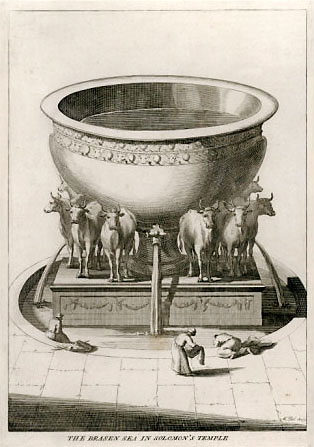The Beauty of Numbers – 1
Bulls and Basins
“You are beautiful as Tirzah, my love, lovely as Jerusalem, awesome as an army with banners.” (Songs 6:4)
An online friend recently questioned the repetition found in Numbers 7. The offerings of each tribe are identical, yet each is listed in full. Surely, this was a waste of expensive parchment? Architecture is important to God, no less literary architecture, and it seems to me that the “fullness” of the Offertory in chapter 7 is the result—or the liturgical response, to the military “forming” of Israel in chapter 2.
At the centre of the five-fold Covenant pattern is the Covenant Ethics. As the Covenant is opened, this becomes three-fold (Law Given, Law Opened, Law Received), creating a Covenant Head (Ascension/Firstfruits), and a Covenant Body (Maturity/Trumpets) united by the Spirit, Covenant fire (Pentecost). This expansion of the three-fold Ethics is what gives us the seven-fold patterns: Creation week, Feasts and Dominion.
In Exodus, the instructions for the Tabernacle are given, and then Israel is tested. She sins concerning the golden calf and is forced to drink it. Then the actual construction of the Tabernacle is described. As a “legal unit,” we have the architectural plans given, opened, and received. The absence of Moses was a deliberate strategy to rid Israel of those unworthy of Levitical worship. And as it turned out over forty years, that was all Israel.
Ascension: Tabernacle plans (heaven)
Testing: Image of the beast – fire (Spirit – 3000 slain)
Maturity: Tabernacle constructed (earth)
In fact, Israel’s sin is also a perversion of the three-fold Covenant Ethics:
Ascension: Idolatry – strange altar
Testing: Adultery – strange fire
Maturity: Apostasy – strange worship [1]
These events correspond to:
Ascension: Leviticus – heavenly man
Testing: Numbers (In the Wilderness) – fiery serpents
Maturity: Deuteronomy – earthly bride
So the architectural “events” in Exodus take on flesh in the larger historical picture as the Mosaic Covenant is “opened.” (Exactly the same thing happens to Israel in the first century after Jesus opens the New Covenant scroll, hence the use of the phrase “image of the beast.” In that case, the image was the Herodian Temple. I recommend James Jordan’s Revelation lecture series for this and many other phenomenal observations. See Newspaper Exegesis.)
So, based on these similar structures, which all find their source in the Testing of Adam by the serpent, it seems to me that Numbers 1-9 describe the recapitulation of the Tabernacle in human flesh. Israel is arranged architecturally around the house of God (measuring out) in chapter 2. Then Israel, as a liturgical prefigurement of all nations, submits willingly to a “bringing in.” Both chapters describe all twelve tribes individually. Numbers 2 is delegation (office conferred), Numbers 7 is vindication (office honoured).
Now, what is really interesting is that we have the twelve tribes and the cleansing of the Levites at Step 6. In the Creation week, this is Land animals and Man. In the festal “week,” this is the Day of Coverings, with animals and the Man as Holy Mediators. In the Tabernacle, this was the Bronze Laver, later glorified “bridally” as the great Bronze Sea. The two-tiered combination of twelve tribes and Levites is the Priestly Man walking on the waters, the springs of the Garden of Eden, in dominion over priestly animals (oxen picture priestly submission). [4] None of this architectural significance is apparent without attention to the literary structure, which appears very strange to us if we don’t know what is going on.
In the Temple, twelve oxen carried the Sea “out of the house.” Here, the tribes are themselves a “horned altar,” twelve oxen carrying the plunder of the nations, including platters and basins, into the house as a tribute to their King. The Church of God leads the world (for good and sometimes ill) in generosity to God in worship.
The platters and basins are an initial “sea of nations.” The Laver and Sea pictured the firmament and the crystal sea, something “beaten out” by God as a place for his governors. Israel’s willingness to offer so much is what vindicates her representation of the house of God as a “temple of flesh.”
Furthermore, I’ll wager that this “architecture” is not only a microcosm of the entire process of Dominion (Egypt to Canaan), but it dictates the pattern for the rest of the book of Numbers. If this is the case, there will be a part two. [5]
____________________________________________
[1] We have seen exactly this process in our own culture, and yet it surprises us. See God Gave Them Up.
[2] See The Eighth Letter.
[3] For more on this, see Bible Matrix II: The Covenant Key.
[4] See Walking on Water.
[5] Just as the first feast, the weekly Sabbath, set the pattern for the festal year, and Daniel 1 sets the pattern for Daniel 1-6: see Daniel’s Long Shadow.


























